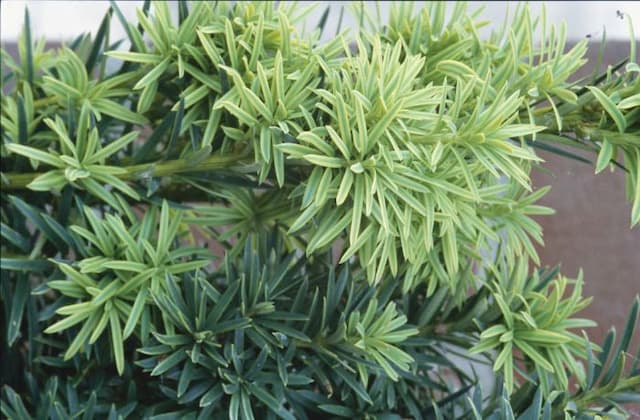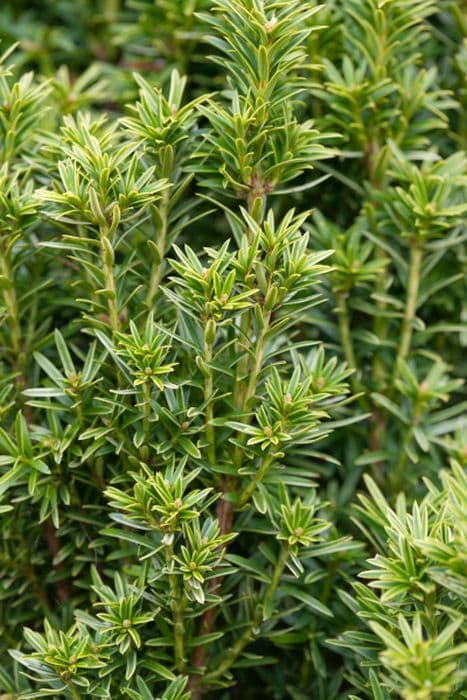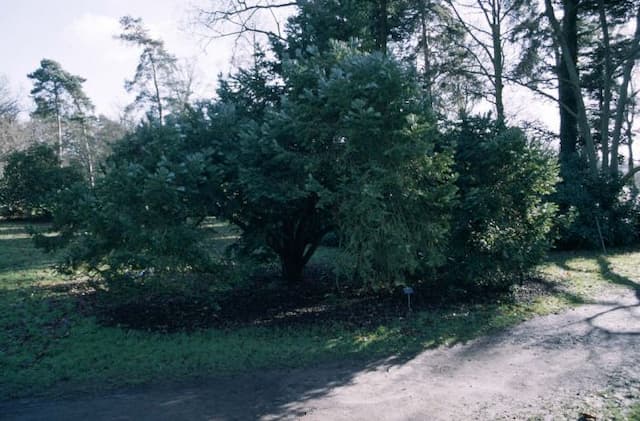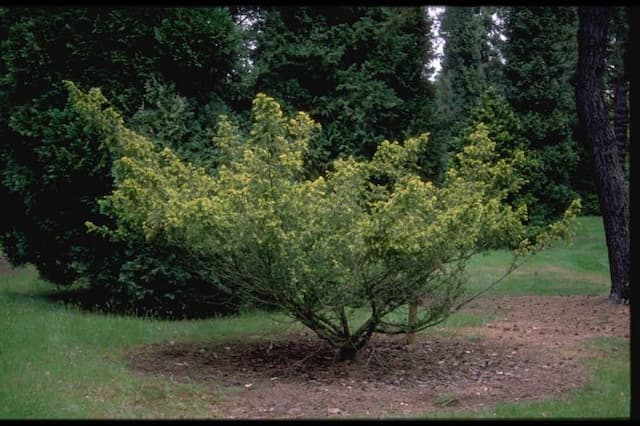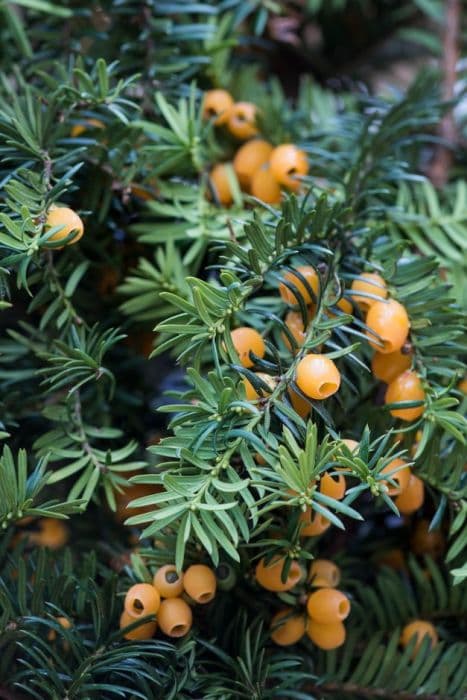Variegated English Yew Taxus baccata 'Adpressa Variegata' (m/v)

ABOUT
The plant known as Variegated English yew has a distinctive and elegant appearance, characterized by its evergreen foliage that brings year-round interest to gardens. The needles of this yew feature a lovely mixture of colors, combining dark green with margins of creamy white, creating a variegated effect that is quite striking. This pattern of green and white on the needles adds texture and variegation, making the plant a standout in landscapes. The Variegated English yew has a natural growth habit that forms a dense, bushy shape with a layered structure, presenting a lush and full appearance. Its needles are arranged spirally along the branches but appear as two flattened rows on either side of the stem due to the twisting of the leaf base. This plant also bears ornamental red berries which contrast beautifully against the variegated foliage, adding to its decorative appeal. These berries have a fleshy, cup-shaped appearance and are typically seen in the fall. Overall, the Variegated English yew's combination of variegated foliage and red berries creates a stunning visual interest that can enhance the aesthetic of any garden setting.
About this plant
 Names
NamesFamily
Taxaceae
Synonyms
Variegated English Yew, Variegated Upright Yew
Common names
Taxus baccata 'Adpressa Variegata'
 Toxicity
ToxicityTo humans
Yew is highly toxic to humans if ingested. All parts, except the red aril surrounding the seed, contain taxine alkaloids which can cause dizziness, dry mouth, dilation of the pupils, weakness, and an irregular heart rhythm which can be fatal. Ingestion can lead to significant morbidity and mortality, with symptoms appearing within a few hours.
To pets
Yew is also extremely toxic to pets, including dogs and cats. Consumption of any part of the plant, except the red aril around the seed, can lead to poisoning. Symptoms include trembling, incoordination, difficulty breathing, gastrointestinal upset, and potential heart failure. Ingestion can quickly be fatal, and veterinary attention is required immediately if consumption is suspected.
 Characteristics
CharacteristicsLife cycle
Perennials
Foliage type
Evergreen
Color of leaves
Variegated
Height
2-3 feet (0.6-0.9 meters)
Spread
1-2 feet (0.3-0.6 meters)
Plant type
Shrub
Hardiness zones
6-7
Native area
Europe
Benefits
 General Benefits
General Benefits- Ornamental Value: Taxus baccata 'Adpressa Variegata', also known as the variegated English yew, adds visual interest to landscapes with its distinctive green foliage edged with creamy white margins.
- Evergreen Nature: As an evergreen shrub, it provides year-round color and structure in gardens, which is particularly valued during the winter months when other plants may have died back or become dormant.
- Low Maintenance: It requires relatively little care once established, making it a convenient choice for gardeners of all skill levels.
- Hedge Plant: With its dense growth habit, it can be pruned into formal hedges or topiary, offering privacy and creating defined spaces within a garden design.
- Drought Tolerance: Once established, it has a good level of tolerance to drought, making it suitable for drier climates or areas under watering restrictions.
- Shade Tolerance: The plant tolerates shady conditions well, making it an excellent option for underplanting beneath taller trees or in parts of the garden that receive limited sunlight.
- Wildlife Support: While it is toxic to humans and animals if ingested, the berries (arils) can provide food for certain bird species during the winter months.
- Adaptability: Taxus baccata 'Adpressa Variegata' can adapt to a wide range of soil types and conditions, albeit preferring well-drained, slightly acidic soils.
- Longevity: English yews are known for their long lifespan, with some individual trees living for hundreds of years, providing a lasting presence in the landscape.
 Medical Properties
Medical Properties- Taxus baccata, commonly known as the English yew, contains several bioactive compounds, notably taxanes such as paclitaxel, which have been utilized in pharmaceutical preparations for the treatment of cancer, especially ovarian and breast cancer. However, these compounds are highly toxic and should never be used without medical supervision.
- The foliage and seed of the yew contain alkaloids that have been studied for their potential anti-inflammatory and antiarthritic properties.
 Air-purifying Qualities
Air-purifying QualitiesThis plant is not specifically known for air purifying qualities.
 Other Uses
Other Uses- Topiary Creations: Yew is often used in topiary gardens due to its ability to be shaped and maintain dense, decorative forms.
- Woodworking Material: The hard and durable wood of yew is sometimes used for making intricate wooden objects such as boxes, handles, and even small pieces of furniture.
- Sound Insulation: The dense foliage of yew can be used in garden design to create barriers that help reduce noise pollution.
- Aesthetic Snow Support: The strong branches of yew can support heavy snowfall, making it a visually appealing choice in gardens prone to snow.
- Privacy Screens: Yew hedges are commonly planted to create living privacy screens due to their thick foliage and height.
- Bonsai Specimen: Due to its dense foliage and the ease with which it can be pruned and shaped, yew is sometimes used in the art of bonsai.
- Shade Tolerance Indicator: Yew can grow in shaded areas, so its presence can indicate areas in a garden suitable for other shade-loving plants.
- Historical Reenactment: Yew wood has been traditionally used for making longbows, and it can be grown and harvested for historical reenactments or educational purposes.
- Habitat for Wildlife: Yew trees provide habitat and food for certain bird species that feed on the berries, and offer shelter to various small mammals.
- Photography Subject: Its variegated leaves and bright red berries make yew a popular subject for garden and nature photographers.
Interesting Facts
 Feng Shui
Feng ShuiThe English Yew is not used in Feng Shui practice.
 Zodiac Sign Compitability
Zodiac Sign CompitabilityThe English Yew is not used in astrology practice.
 Plant Symbolism
Plant Symbolism- Immortality: Taxus baccata, commonly known as Yew, is often considered a symbol of immortality due to its long lifespan and ability to regenerate. It can live for thousands of years, and even when the trunk dies, new shoots can grow from the base.
- Death and Resurrection: The Yew tree is associated with death and resurrection partly because it is often found in churchyards where it is believed to have been planted to signify the hope of rebirth following death.
- Eternal Life: Yew is symbolic of eternal life, as its evergreen nature represents everlastingness, and it maintains its greenery all year round.
- Transformation: Due to its ability to renew itself, the Yew can also represent transformation and change, symbolizing the shifting cycles of life.
- Protection: In ancient times, the Yew was believed to protect against negative forces and was often planted near sacred sites as a protective shield.
 Water
WaterThe Variegated English Yew should be watered deeply but infrequently, with more frequent watering during its first growing season to establish a strong root system. Aim to keep the soil moist but not waterlogged. Typically, watering once a week with about 1 to 1.5 gallons of water is adequate for established plants, but this may vary depending on soil type and weather conditions. During hot, dry periods, additional water may be necessary. Adjust the watering frequency during the winter when the plant requires less moisture.
 Light
LightVariegated English Yew prefers a spot with full sun to partial shade. It can tolerate full sun in cooler climates but does best with some afternoon shade in hotter areas. The ideal location would provide morning sunlight and protection from the intense heat of the afternoon sun.
 Temperature
TemperatureThe Variegated English Yew is hardy and can tolerate a wide range of temperatures, from as low as -20°F to as high as 90°F. However, the ideal temperature range for this plant is between 60°F and 70°F. Ensure it's protected from harsh winter winds and frost to prevent damage to the foliage.
 Pruning
PruningPruning the Variegated English Yew is essential to maintain its shape and to remove any dead or diseased branches. The best time for pruning is in late winter or early spring before new growth begins. Light pruning can be done throughout the growing season if necessary. For major reshaping, it is best not to prune more than one-third of the plant at a time.
 Cleaning
CleaningAs needed
 Soil
SoilVariegated English Yew thrives in well-draining soil with a mix of two parts loam, one part peat moss, and one part sand or perlite. The soil pH should range from slightly acidic to neutral, around 5.5 to 7.5.
 Repotting
RepottingVariegated English Yew generally requires repotting every 3-4 years to refresh the soil and provide room for growth.
 Humidity & Misting
Humidity & MistingVariegated English Yew prefers moderate humidity levels but is tolerant of both lower and higher humidity environments, making it versatile in various indoor settings.
 Suitable locations
Suitable locationsIndoor
Place in bright, indirect light; avoid drastic temp changes.
Outdoor
Full sun to part shade; shelter from strong winds.
Hardiness zone
6-7 USDA
 Life cycle
Life cycleTaxus baccata 'Adpressa Variegata', commonly known as the Variegated English Yew, begins its life cycle as a seed, which germinates in a moist, well-drained environment, typically taking several weeks to a few months. After germination, the seedling goes through a juvenile phase, developing a root system and foliage over the course of several years while remaining relatively small and bushy. As it matures into adulthood, the yew grows slowly, developing a woody stem and reaching its full size, which can be up to 6 to 10 feet tall and wide, with a tightly packed, conical shape. It can take decades for this yew to reach its mature phase, during which it produces both male and female cones; however, being a cultivar, the 'Adpressa Variegata' might predominantly propagate through cuttings rather than seeds. Once mature, it produces its characteristic red arils, which are fleshy structures that surround the seeds and can be attractive to wildlife but are toxic to humans. The plant has a long lifespan, often living for several centuries, during which it remains mostly in its adult form, with regular yearly cycles of growth, cone production, and dormancy in the winter.
 Propogation
PropogationPropogation time
Early Spring
The English Yew 'Adpressa Variegata' is most commonly propagated through semi-hardwood cuttings. This method is usually carried out in late summer to early fall. Cuttings about 6 to 8 inches (15 to 20 cm) long are taken from the current year's growth. The lower needles are removed to expose a clean stem, which is then dipped in rooting hormone to encourage root development. The treated cutting is inserted into a well-draining soil mix and kept moist and under partial shade until roots have formed, which may take several weeks to a few months. A plastic cover or mist system is often used to maintain high humidity around the cutting to prevent it from drying out during this root formation period.
